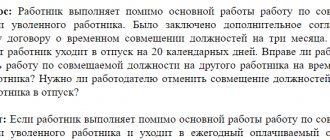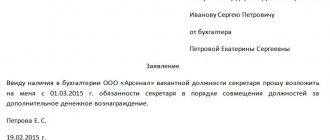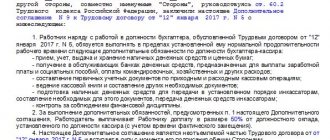Hiring during maternity leave of the main employee
The rights of women who go on maternity leave are protected by the state.
The manager is obliged to maintain the job until the woman returns from maternity leave. When maternity leave ends, she can return to her reserved place. The law provides that during the absence of the main employee, management can hire a temporary employee for this position.
There are several options:
- conclude a fixed-term employment contract with a new employee;
- transfer someone from the staff to a vacant position;
- entrust another employee with some or all of the part-time duties of a woman who has gone on maternity leave.
The first two options are the most popular in practice: this is due to the fact that parental leave can last up to three years.
Read more about the specifics of registering and dismissing a temporary employee later in the article.
What to do if the employer has not concluded an employment contract with the employee?
Probation
The head of the enterprise must provide an option for a temporary employee such as a probationary period. It may not be installed, but the employer has the right to do so if he wishes.
The following probationary periods exist:
- for most middle and junior level employees – no more than three months;
- for employees hired for a period from 2 to 6 months. – no more than two weeks;
- for deputy heads, chief accountant and his deputy, as well as heads of structural divisions - no more than six months.
The probationary period of work is displayed in the employee’s work book. If the employee has shown high achievements and he fully satisfies the employer, then an additional agreement is drawn up to the employment contract, according to which the probationary period is reduced. After this, the temporary worker has the right to enjoy all the privileges of the main employees of the enterprise. This could be an appointment to a clinic, sanatorium treatment, etc.
What difficulties may arise in the future with the probationary period of a temporary worker? For example, if a maternity leaver is completely satisfied with the manager as an employee, but there is a high risk that she may not return after her vacation, then the manager has the right to hire a more qualified employee than the one who performed the duties of a maternity leaver. Otherwise, after the expiration of maternity leave, the question will arise of how to get rid of unqualified personnel, because there are no grounds for terminating the contract.
This is precisely why a probationary period exists, however, most enterprises solve this problem in the following way - they register the maternity leaver as having worked at least one day, after which the employment contract with the temporary worker loses its force. And only then the employee writes a letter of resignation, and the company begins recruiting again.
How to hire an employee during maternity leave?
Questions and answers on the topic
Our employee wants to go first on basic leave, then on maternity leave, then on childcare leave. Can we immediately, starting from the main vacation, hire her in her place? How to formalize this and what to write in the order and contract so that everything goes smoothly and does not draw up a bunch of papers. I understand correctly that we can hire an employee, even for the period of the main vacation, even for the period of sick leave of the main employee.
Answer to the question:
The end of the term of an employment contract can be determined by the occurrence of a certain event (completion of work under the contract, end of the season, departure of an absent employee for whose temporary replacement a conscript employee was hired).
This procedure is provided for in Article 79 of the Labor Code of the Russian Federation.
The basis for concluding a fixed-term employment contract during the performance of duties is the temporary absence of the main employee, who retains his place of work (Article 59 of the Labor Code of the Russian Federation). The reason for such absence may include employee vacation, temporary disability or parental leave, etc.
The end of the period should be indicated as follows: “Until the departure of the main employee Ivanova E.I.” or “for the period of absence of the main employee Ivanova E.I.”
Thus, the need to terminate a fixed-term employment contract will arise only when the main employee starts work.
Fill in both date cells “from” and “to” (in form No. T-1, the date is in the “Hire” column, and in form No. T-1a - in the “Work period” column). If the term in the contract is determined not by a specific date, but by an indication of an event, the “to” cell will contain the corresponding text. For example, “by the date of departure of a temporarily absent employee.” To make it fit, the cell needs to be expanded
When terminating a fixed-term employment contract, make an entry in the work book: “Dismissed due to the expiration of the employment contract, clause 2 of part 1 of Article 77 of the Labor Code of the Russian Federation.” An exception to this rule will be cases where the employment relationship actually continues and neither party has requested its termination.
Details in the materials of the Personnel System:
The basis for concluding a fixed-term employment contract during the performance of duties is the temporary absence of the main employee, who retains his place of work (Article 59 of the Labor Code of the Russian Federation). The reason for such absence may also be the employee’s vacation. Moreover, it does not matter what specific vacation the employee is on. This could be: annual paid leave, unpaid leave, educational leave, etc.
Thus, the organization has the right to conclude a fixed-term employment contract with a new employee while the main one is on vacation. When concluding a fixed-term contract, you can use the wording “Until the main employee returns to work from vacation.”
A similar approach applies when concluding a fixed-term employment contract for the duration of a business trip, illness, temporary transfer and other cases of absence of the main employee.
Deputy Director of the Department of Medical Education and Personnel Policy in Healthcare of the Russian Ministry of Health
In this case, the end of the employment contract should not be indicated as a specific date. A young mother can start working before her vacation ends. If this happens, there will be two legally employed employees at one workplace. Therefore, indicate the end of the period as follows: “Before the departure of the main employee Ivanova E.I.” The possibility of linking the end of an employment contract with the occurrence of a certain event is expressly provided for in Article 79 of the Labor Code of the Russian Federation. At the same time, it is also not necessary to specify that this will be exactly an exit from maternity leave, since after such a leave the employee can exercise, for example, her right to go on annual leave unscheduled, and then it turns out that she will no longer return to work. from maternity leave and from annual leave. That is, the event that marks the end of a fixed-term contract with a temporary employee will not happen, and a conflict may arise over the legality of his dismissal.
Deputy Director of the Department of Medical Education and Personnel Policy in Healthcare of the Russian Ministry of Health
- Situation:
is it possible to hire an employee under a fixed-term employment contract while the main employee is on vacation? - Situation
: for what period can an employment contract be concluded with an employee who is hired during the parental leave of the main employee? - Table:
Features of the preparation of personnel documents when concluding a fixed-term employment contract with an employee
Entry in the work book
And the last document that puts an end to the paperwork is the entry in the work book about employment under a fixed-term contract during maternity leave, which is made after the application of the new employee. An interesting fact is that most lawyers do not advise entering the word “fixed-term employment contract” into the work book. And in some cases they are right. For example, if a maternity leaver decides not to work in a given company after three years, then she can quit directly from her vacation without working a single day.
Please note: as you can see, there are no grounds for ending the contract, because the maternity leaver has not started work, and the new employee can work indefinitely. The contract with the employee becomes concluded for an indefinite period, which makes it possible not to make changes either to the order or to the work book.
As a rule, I do not indicate in the work book that a fixed-term contract has been concluded with the employee.
Termination of an employment agreement on maternity leave
The nuances of a fixed-term employment agreement come down to ensuring a comfortable process for all participants and, no less important, legal termination of temporary work. In a broad sense, such an agreement can be terminated in the same way as any other - before the end of its validity period: Recent Posts Is it possible to give a mirror as a gift: how to protect yourself from bad omens It became known about the influence of cell phone towers on human health Is it possible to eat bananas bought in Russia?
Recent Posts Is it possible to give a mirror as a gift: how to protect yourself from bad omens It became known about the influence of cell phone towers on human health Is it possible to eat bananas bought in Russia?
- transfer to another position (the procedure is the most common - without specific nuances);
- dismissal at the request of the employee (the procedure is traditional - it is enough to notify the employer two weeks in advance);
- dismissal due to circumstances beyond the control of the parties or at the initiative of the employer (everything happens in accordance with the general norms of the Labor Code).
A specific situation is of much greater interest - the completion of temporary work in connection with the expiration of the contract - a maternity leaver going to work (either urgently or early). There are also two options here - dismissal and transfer.
In accordance with a fixed-term employment agreement and basic rules of logic, the last working day of the employee replacing the maternity leave is the one that precedes the day she goes to work. Two current employees cannot be in the same staff position, and you can quit or transfer earlier than this day for the reasons listed above.
Dismissal
Art. 79 of the Labor Code requires employers to warn temporary employees about the expiration date of the contract three days in advance. Apparently, in order to avoid conflict situations (for example, a maternity leaver suddenly leaves without warning anyone, or a former temporarily disabled employee is given unscheduled sick leave), in the case of replacing an absent employee, this obligation of the employer has been cancelled.
Termination of employment relations occurs in the usual manner, the basis is clause 2, part 1 of Art. 77 TK. Its stages are:
- Issuance of an order (unified form T-8). The person being dismissed should be familiarized with the document.
- Making payments is mandatory on the last working day (this must be preceded by drawing up a timesheet taking into account dismissal).
- Making an entry in the work book, personal card form T-2, notice of dismissal to interested government agencies.
Translation
It also happens that a temporary employee has shown himself to be a good performer (the management does not want to part with him), and at the time of the expiration of the employment agreement with him, there is a suitable vacancy in the company. If the employee also agrees to continue working, the situation is resolved by a simple transfer.
The company where I work has a predominantly female team (maternity leave is not uncommon). Therefore, it often happens that during his working life an employee goes through more than one, or even two, maternity places. By skillfully rotating personnel, our management developed the confidence among the team that if you have good business qualities, there is no need to be afraid of a temporary position - you will definitely (perhaps even more successfully) be transferred in anticipation of the end of the employment contract. By the way, an even more extraordinary (but completely legal) thing is practiced - “switching” an employee on sick leave and employee vacations at intervals when there are no more or less permanent positions, but they are planned in the future, and the employee is good and you don’t want to let him go. I myself have more than once found myself as such a “very temporary worker,” but I don’t regret it at all (the only negative is that the work book is excessively covered with translations).
There are no specifics to such a transfer - it is made either at the request of the employee, or by notifying the employer of the availability of a vacant position with an offer to fill it (of course, the employee’s consent is required). The procedure is as follows:
- Receipt of a supporting document (application with the manager’s resolution or notification with the employee’s consent).
- Drawing up an order (unified form T-5). The employee must be familiarized with the order.
- Concluding a new employment agreement, entering information about the transfer into the work book, T-2 card.
Termination of a fixed-term contract
If the exact date is not specified in the employment contract, it ends when the main employee returns to work. When a woman on maternity leaves for part-time, the contract with the new employee is not terminated.
To fire a temporary employee, you need to complete the following documents:
- an order to leave a key employee;
- order to terminate a fixed-term contract.
You also need to make an entry in the work book and personal registration card stating that the temporary employee was fired due to the return to work of the main one.
After this, the replacement employee is considered dismissed and receives a work book. Within a month, all necessary monetary compensation is transferred to him.
For many, an employee going on maternity leave becomes a real problem, and they begin to wonder how to register a new employee.
The procedure goes through 4 stages: writing a job application, concluding a fixed-term contract, signing an order and making an entry in the work book. This scheme is still relevant today, in 2020.
Download:
Application for employment during maternity leave - Sample.doc
Order for employment during maternity leave - Sample.doc
Employment contract for the period of maternity leave of the main employee - Sample.doc
Similar articles:
- How to write an application for maternity leave?
- Do they have the right to lay off or fire a husband if his wife is on maternity leave?
- How to leave maternity leave early?
- What payments are due during maternity leave?
- Is it possible to work another job while on maternity leave?
- Previous post What is maternity pay at work?
- Next post How long is maternity leave?
Comments on the article “How to register an employee during maternity leave of the main employee?”
Nobody has written anything yet. Be the first!
Purposes of compilation
As a rule, a particular position in a particular institution is created due to the presence of a certain amount of work, which is smoothly distributed based on 40 hours of workload per week.
Naturally, if a full-time employee is absent even for a short time, for example, in case of illness or taking annual leave, his duties are performed by other employees for additional pay.
But short-term replacement only involves covering current cases that cannot be rescheduled for another period. But the entire amount of work will still have to be done by an already recovered or rested employee.
In the case of a long absence, for example, in connection with the upcoming birth and maternity leave, the situation is much more complicated. In most cases, it is impossible to attract an existing worker to perform duties for two positions due to the unbearable load.
That is why in such a situation there are only three options determined by law:
- accept a new employee, but on a fixed-term contract basis, that is, during the absence of the main employee;
- transfer an existing employee with complete release from his previous duties, again on a temporary basis;
- use a part-time worker, both internal and external.
How to properly prepare a document
It is important to specify in the text of the contract the conditions for termination of cooperation in order to avoid a situation where the main employee has already returned to work, but the temporary one has not yet been terminated. And this is possible, since sometimes key employees return from parental leave ahead of schedule.
Note! In a fixed-term contract, it is better to include the wording that it is concluded for the period of temporary absence of the main employee in connection with the birth of a child and caring for him.
Since there are cases when the main employee extends maternity leave (takes out parental leave), an additional agreement can be concluded with a temporary employee to extend the contract for the period while the main employee is on parental leave.
Part-time work after maternity leave
M? RESULTS RESULTS. RESULTS 256 RESULTS. RESULTS RESULTS, RESULTS к ÑабоÑодаÑÐµÐ»Ñ Ð¸ ÑообÑиÑÑ Ð¾ Ñвоем желании. RESULTS ROOM договоÑÑÑ. RESULTS ¼Ð°ÑиÑ:
- RESULTS ½ÐµÐ´ÐµÐ»Ð¸;
- regurgitation;
- RESULTS.
Amount of benefits during maternity leave with a fixed-term employment contract
The procedure for calculating all payments in connection with maternity is established at the legislative level.
Sick leave is paid at 100%, regardless of work experience. For the calculation, wages are taken for the 2 years that precede the year of maternity leave. For example, in 2020, the amount of accruals will be calculated from wages for the period 2016-2017.
A one-time benefit for the birth of a baby and payment for registering a pregnant woman up to 12 weeks are established in fixed monetary terms. As a rule, they change annually, with an increase in the minimum wage.
Monthly payments for caring for a newborn are paid in the amount of 40% of average earnings. The basis for calculation is also the 2 previous years.
When calculating, it is necessary to take into account the following nuances:
- If the employee does not have an official salary in the specified periods, or it is less than the minimum wage, then the calculation base is calculated based on the minimum wage. Accordingly, there is a threshold below which sick leave and child care benefits do not fall.
- There is also a maximum salary limit that will be included in the calculation of the required amounts. It changes every year. For example, in 2020 the maximum annual income for calculation is 670,000 rubles, and in 2020 – 718,000 rubles. This means that the upper limit of payments is also limited.
Normative base
The procedure for concluding a fixed-term contract is regulated by the norms of Article 59 of the Labor Code of the Russian Federation, where paragraph one indicates the possibility of hiring a new employee to replace an absent worker, for whom a job is retained for the period of vacation within the framework of the law.
Moreover, within the framework of this article, an agreement on mutual cooperation can be concluded only for the time specified in the order for the same provision of leave for the BiR or for caring for an infant.
But the procedure for temporary transfer is already established in Article 72.2 of the Labor Code of the Russian Federation. According to it, an employee can be transferred, with his written consent, to another position to replace a worker who is absent due to the same maternity leave, until its end.
Moreover, if the new performer, on the eve of the end of the transfer period, did not demand that his previous position be returned to him, he is considered transferred on a permanent basis.
This is only possible if the maternity leaver quit for some reason without returning from vacation.
And the possibility of replacing a temporarily absent employee in a part-time mode is covered by the norms of Chapter 44 of the Labor Code of the Russian Federation.
It states that a part-time worker can perform his duties only in his free time from his main job and only no more than half of the normal working hours per month.
It should be noted that transfer to maternity leave, as well as part-time work, have certain nuances that may create difficulties in the future:
- during the transfer, the previous position of the replacement employee may already be occupied and he will have no place to return to after the end of the main worker’s maternity leave;
- part-time work requires a separate work schedule, and only half the normal working time, which is also not suitable for everyone, especially if you have to work on a five-day schedule for eight hours every day;
- a part-time worker will have to be provided with full leave and all the guarantees provided for by the Labor Code of the Russian Federation in full, while he will only work half a shift.
Thus, many employers, trying to avoid unnecessary complications, initially use the first and most convenient option.
They hire a new full-time employee with the obligation to perform the entire range of duties for the next three years under the regime of a full-fledged employment contract concluded for a certain period, that is, until the main employee returns from maternity leave.
What is needed to apply for maternity leave?
The law establishes that women, upon their application and on the basis of a certificate of incapacity for work, are granted maternity leave, which is issued by order of the employer on the unified form No. T-6, with which the woman must be familiarized with her signature.
In order to issue an order for 140 days of maternity leave, a woman must receive a certificate of incapacity for work, which is issued by a doctor (in the absence of a doctor, a paramedic) at the 30th week of pregnancy (in the case of a multiple pregnancy at the 28th week). Without a certificate of incapacity for work, the employer does not have the right to issue this type of leave.
On the sick leave, the doctor indicates the duration of calendar days of incapacity for work: from 140 calendar days for a singleton pregnancy to 194 days for a multiple pregnancy (for more details, see paragraphs 46-51 of the Procedure for issuing certificates of incapacity for work, approved by Order of the Ministry of Health of Russia dated June 29, 2011 No. 624n).
From the moment of receiving a certificate of incapacity for work, the employee has the right to write an application for maternity leave, the main provisions of which are set out in Article 255 of the Labor Code of the Russian Federation. The order for maternity leave (sample 2020) is presented below.
Sample application for maternity leave
Unified form T-6
This type of document refers to orders for personnel and is subject to storage for 75 years (clause 6 of the List of standard management documents..., approved by Order of the Ministry of Culture of the Russian Federation dated August 28, 2010 No. 558.
Sample order for granting maternity leave
In what form?
The legislator establishes a procedure for hiring all categories of workers, mandatory for use by employers, regardless of the form of ownership of the legal entity or the organizational form of the enterprise.
However, in accordance with the requirements of office work, the hiring of a new employee must be accompanied by the publication of an administrative document - an order from the manager on hiring.
The order is issued by the directorate regardless of the conditions of employment, and employment in a temporary position due to the main employee being on maternity leave is no exception.
The legislator does not oblige employers to adhere to a uniform form of employment order.
It is drawn up in any form, on the company’s letterhead, a sheet of A-a format or a unified form developed by the State Statistics Committee.
When deciding to use a certain form of the submitted document, the employer is guided by the convenience of its preparation and further use.
When issuing a free-form order, the aspect of accepting a temporary position due to the employee being on maternity leave is displayed in the header of the document.
In the unified form, the information provided is indicated in the “conditions of admission” column.
Documents grounds for employment in the place of a maternity leaver
The main basis for hiring a temporary worker to replace a woman on maternity leave to care for a child is the will of such a potential worker, formalized in the form of an application for employment.
This form is also not determined by the requirements of the legislator and can be drawn up in any form.
For the type of employment presented, it is mandatory to indicate in the application that the position for which the applicant is applying is of a temporary nature (for the period of maternity leave of the main employee).
Such information will avoid further occurrence of labor disputes regarding the worker’s awareness of the instability of the position held.
In addition to the application, the grounds include a list of mandatory documents provided by a potential employee upon employment (the list is enshrined in the Labor Code of the Russian Federation):
- identification document of the potential employee;
- official documents confirming that the candidate has the appropriate education;
- work book confirming the required work experience;
- military registration or military ID, etc.
How to fill out form T-1 when taking maternity leave?
It was stated above that the legislator does not oblige employers to use a unified form for hiring an employee for a temporary position in connection with maternity leave.
However, the use of this form is quite common due to its ease of use.
Completing the presented form is identical for all types of employment with the exception of the line “conditions of admission”, which indicates information about the temporary nature of the vacant position held.
The form must be filled out by hand or using computer technology.
As a rule, this order is drawn up personally by the manager, but it is acceptable to fill it out by an authorized employee with the signature of management.
Information is entered without any blots or errors, in accordance with business writing style.
The acceptance order contains information about the employees responsible for the implementation of such a document. These workers must be familiarized with the order against signature.
The completed orders must be registered in a journal - sample.
orders T-1 and T-1a can be found here.
Answers to common questions
Question No. 1. “I was hired during the maternity leave of one employee. At the same time, I was given a probationary period. It is legal?"
Absolutely legal. According to the Labor Code, Article 70, Part One, the employer has the right to establish a probationary period for a temporary employee. However, there are restrictions on the probationary period. If you have been hired for a temporary position for a total period not exceeding six months, the probationary period may be two weeks or less. In other cases, the probationary period is limited to three months (with some exceptions). Moreover, the trial period set for you must be specified in the contract.
Question No. 2. “Can I be offered a lower salary when replacing a temporary employee?”
No. If you hold the same position with the same functions, your salary should be exactly the same. In some cases it may be higher, for example, if new responsibilities are added to you or if you receive a bonus.
Question No. 3. “Can an employer fire an employee if the contract has already expired and he is on sick leave?”
Can. The fact is that according to the law (Article 81 of the Labor Code), it is impossible to terminate a contract with an employee during illness. But it is not possible only at the initiative of the employer. The decision to terminate a fixed-term contract is not the employer’s initiative, so it is possible to terminate a contract with a temporary employee even during his illness.
Termination of contract
If the contract does not stipulate a specific end date, and it was concluded for the duration of the duties of a temporarily absent specialist, its validity is terminated upon the return to work of the main employee (Part 3 of Article 79 of the Labor Code of the Russian Federation).
The day of termination of the contract in this case is the date that precedes the start of work of the main specialist. If this date falls on a holiday or day off, the moment of termination of the employment relationship in accordance with Art. 14 of the Labor Code of the Russian Federation, it will be the next working day.
If a temporary employee exercises the right provided for in Part 3 of Art. 127 of the Labor Code of the Russian Federation, and the vacation ends after the expiration of the contract, the last working day will be considered the day the vacation ends.
Payments due
Wages must be paid to an employee filling a temporarily vacant position in the same manner as to an employee who is temporarily absent due to child care. All payments provided to the employee are divided into the following:
- mandatory, which consist mainly of those payments that are fixed in the employment contract and are in the nature of payments as payment for the work functions performed;
- additional, which are most often of a bonus nature and are aimed at stimulating the employee to better perform his job duties;
- compensation and auxiliary benefits, which are provided at the request of the employee and are designed to improve his financial situation in a given period of time (for example, when going on paid leave in order to have something to live on after such leave).
A temporary worker is entitled to all payments due, as well as all benefits that are provided to the employee by the employer on the basis of existing rules in the organization, since such an employee performs his functions under a concluded employment contract, and such a place of work will most often be his main one.
If for some reason a temporary worker finds himself in a difficult life situation, he also has the right to receive additional social benefits in the nature of support measures, as well as to receive leave, which is provided for by the Labor Code as provided for family reasons. An employer's refusal to provide such benefits or leave may be considered unlawful.
Dear readers, each case is individual. If you want to find out how to solve your particular problem, call:
- Moscow.
- Saint Petersburg.
- Regions.
Temporary worker rights
Hiring a temporary worker retains all rights stipulated by law. In particular, a temporary worker has the right:
- receive the salary established in the employment contract, and the amount of the salary should not be less than what the maternity employee received;
- to increase wages with a general increase in the enterprise, when performing complex, overtime work, as well as upon achieving seniority;
- to receive a bonus;
- for annual, unpaid or additional leave;
- compensation for unused vacation upon dismissal;
- payment of benefits from social insurance funds.











